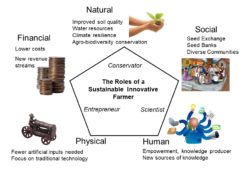What is Sustainable Seed Innovation?
Sustainable seed innovation happens when farmers improve upon traditional varieties through field observations and seed selection. Value lies in the process of innovation independent of the outcome (a new plant variety).
The process of sustainable seed innovation involves:
- Seed storage techniques and seed-saving
- Field observation and seed selection
- Seed exchanges
- Agrobiodiversity conservation
- Potentially new plant varieties
Social, Economic and Environmental Sustainability
Adapted to local environments, traditional varieties grow best without the use of chemical fertilizers and pesticides, and require less irrigation. As a result, when a farmer saves the seeds of traditional varieties, they need not purchase external inputs, thereby saving money and the environment.
Informed consumers seeking out healthy, climate-resilient and tasty traditional varieties creates new revenue streams for farmers.
In a truly sustainable model, the farmer fulfills the roles of scientist, conservationist and entrepreneur. From the creation and recognition of new knowledge and innovations, the farmer becomes empowered.
Finally, the traditional ways of seed exchange strengthened the social fabric of farming communities and provided networks of knowledge exchange.
Development communities refer to this as the improvement of the five capitals of sustainable livelihoods: financial, physical, natural, social and human as illustrated below.

Read more about sustainable seed innovation in our collection of farmers' stories.
